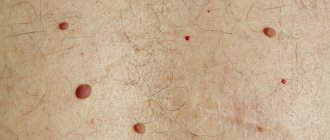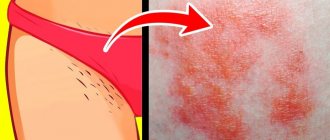Inguinal candidiasis is more often diagnosed in men than in women. The pathology belongs to the category of candidiasis of large folds and is characterized by severe symptoms, causing the patient discomfort and many unpleasant symptoms. The main cause of fungal disease is a decrease in the body’s protective functions under the influence of negative internal and external factors. Treatment of inguinal candidiasis should be carried out under the strict supervision of a physician. An important point is to identify the root cause that provoked the spread of fungal infection. Without its elimination, the risk of the disease progressing to the chronic stage, which is manifested by periodic relapses, increases. Medical specialists quickly diagnose the pathology and prescribe the most effective treatment, taking into account the individual characteristics of the patient’s body. Our doctors pay enough attention to each client to achieve the most positive therapeutic results and prevent complications.
Symptomatic picture of mycosis
Candidiasis of the inguinal folds is caused by specific fungi, which are opportunistic microorganisms that live on the skin and mucous membranes of any healthy person. The immune system, functioning without failures, suppresses the active activity of pathogenic microflora, so they remain in a latent state in the human body. However, under the influence of pathological exogenous and endogenous factors, the immune system is weakened and ceases to fully perform its functions. This contributes to the activation of the infection and its unhindered reproduction.
The active activity of a fungal pathogen on the skin in the groin area is manifested by the following pathological symptoms:
- Formation of spots in the groin. The lesions have clear boundaries and differ in color from healthy areas. The shade of the spots ranges from light pink to deep red.
- Peeling of the skin. In places where a fungal infection is localized, the skin becomes covered with a white coating and peels off. Peeling may spread to the perianal and pubic areas, as well as to the folds of skin between the groin and thigh.
- Uncomfortable sensations. In the groin area, the patient is bothered by severe, sometimes unbearable itching, which can cover the femoral part of the lower limb.
- Irritation. Swelling, redness, and irritation form at the site of active fungal activity.
On the skin of the groin area affected by the fungus, round, deformed areas are visualized, which differ from healthy skin in shade and the presence of peeling on the surface. Thanks to such visual signs, the doctor can make a preliminary diagnosis, which will be confirmed by the results of a comprehensive diagnostic examination.
Popular questions
Irritation on the pubic area under the hair.
What to do? You need to understand what caused this: an allergic reaction, a bacterial, fungal or viral infection, or an injury during depilation. For this, a consultation with an obstetrician-gynecologist, and in some cases a dermatologist, is required. Only then will it be possible to recommend suitable treatment.
Severe itching on the labia, irritation. There is nothing to worry about in the vagina itself. What could it be?
This may result in an allergic reaction or inflammation. I recommend using Ginocomfort gel with mallow extract, applying it once a day to the discomfort zone for 7 days. If you do not notice relief, consult a doctor.
I am 69 years old. I am concerned about vaginal irritation and dryness. I was treated once with Triozhinal suppositories. The result was positive for 1.5 years. Now this problem has arisen again. But now these candles cause a strong burning sensation. Today I am flying to the sea, and I am afraid that I will not be able to swim, since the salt water is making the problem worse. Please advise what I can do. Thank you! Hello! During the postmenopausal period, inflammatory processes develop in the genital tract against the background of atrophic changes in the mucosa caused by hormone deficiency. Its layers become thinner, elasticity decreases, and the number of lactobacilli decreases. In this situation, a study is required: a smear for flora, oncocytology. The first step is to prescribe drugs with anti-inflammatory activity, and the second step is to moisturize, restore microflora, and, in the absence of contraindications, local hormone-containing suppositories. A feature of treatment in this age group is continuous maintenance therapy. At this stage, before receiving the results of the study, you can use Ginocomfort gel with mallow extract, which will have anti-inflammatory and moisturizing effects. The gel is applied in 1 dose 1 time per day for 10-14 days.
Hello! Is it possible to feel a burning sensation and irritation when using Gynocomfort?
Hello!
A slight tingling sensation may be felt immediately after administration, but will quickly subside on its own. If this happens, then you should continue to use the gel. For an accurate diagnosis, contact a specialist
Athlete's inguinal
The disease is caused by fungi of the genus Epidermophyton floccosum. The infection is transmitted through household contact and most often affects men. Factors that provoke the development of the disease include:
- wearing tight, constricting clothing that disrupts natural air exchange in the groin area;
- profuse sweating;
- increased environmental humidity;
- frequent injury to the skin in the groin;
- inactive lifestyle;
- excess weight.
In the initial stages of development, the infection is localized in the skin folds of the genital area, but as it progresses it spreads to the upper part of the inner thigh, affecting both limbs. Usually the fungus does not affect the skin of the scrotum.
The rash has a scaly, pinkish border. Inguinal athlete's foot is often accompanied by itching and pain symptoms. Lack of timely treatment leads to an increase in lesions and the spread of infection to healthy tissue.
To prevent the development of inguinal athlete's foot, it is advisable to follow simple rules of prevention:
- wear comfortable underwear made from natural fabric;
- observe the rules of personal hygiene, especially in saunas and swimming pools;
- use personal hygiene items and do not give them to any strangers;
- normalize body weight;
- add moderate physical activity;
- If you have characteristic symptoms of a fungal infection, do not self-medicate, but make an appointment with a dermatologist as soon as possible.
Cream or soap: how to properly care for the skin in intimate places?
- Use only special cosmetics for delicate intimate care. It contains natural ingredients, does not cause allergic reactions and is suitable for gentle cleansing of delicate areas. The composition of GINOCOMFORT washing gels corresponds to modern recommendations of gynecologists - GINOCOMFORT intimate cosmetics are not only suitable for daily care, but also help to maintain the cleanliness of the genitals during menstruation and during the treatment of gynecological diseases, when the body is especially vulnerable.
- If possible, wear comfortable underwear made from natural fabrics. If you want to wear erotic panties, be sure to take a shower before putting on such panties, and also change your underwear before going to bed - sleeping in thongs can increase the level of pathogenic bacteria in the vagina.
- Maintain personal hygiene: obstetricians-gynecologists recommend washing yourself 1-2 times a day, during menstruation up to 4 times a day, if possible, with each pad change.
Pads and tampons should be changed every 3-4 hours, regardless of the amount of discharge. - Pay attention to contraception: if you are allergic to latex, choose condoms made from other materials.
- Visit your obstetrician-gynecologist at least 2 times a year to rule out the development of diseases.
And remember: irritation in the intimate area, even if it just “itches” and there are no other more serious symptoms, is not the norm, and this condition is most often easy to eliminate.
There is no need to avoid the possibility of solving an unpleasant problem. The right cosmetics and treatment selected by an obstetrician-gynecologist will allow you to regain confidence in your beauty, comfort, feeling of freshness and good mood every day. Sources:
- Inflammatory diseases of the female genital organs. Modern perinatal technologies in strengthening the reproductive health of patients. Naumov I.A. // Monograph. Saarbrucken: LAP LAMBERT Academic Publishing GmbH end Co. KG. — 2011. — pp. 18–21.
- Microbiological characteristics of biotopes of the reproductive tract with endometritis. Glukhova E.V., Shakhovskaya I.N. // Togliatti honey. consultation – 2008. – 1 (2): pp. 38–44.
- Medical and social characteristics and forecasting of reproductive health of young women at the present stage. Torubarov S.F. // Social aspects of public health. – 2013. – 5 (33): P. 7.
- https://ciplamed.com/content/important-tips-to-maintain-intimate-hygiene
- https://www.lactacyd.eu/your-intimate-zone/
- https://www.medicalnewstoday.com/articles/321537.php
Candidiasis in the groin area
The causative agent of candidiasis in the groin area is a yeast-like fungus of the genus Candida, which belongs to the opportunistic microflora and lives on the skin and mucous membranes of every healthy person. With natural balance and proper functioning of the immune system, the infection is in a latent state and does not provoke the development of pathological processes. But as soon as the immune defense fails, the fungi are activated and begin to multiply unhindered, causing the formation of deformable surface changes, accompanied by pathological symptoms.
Common causes of candidiasis in the groin area are:
- obesity, accompanied by the appearance of large folds on the skin;
- endocrine, hormonal disorders;
- failure to comply with personal hygiene rules;
- uncontrolled use of certain groups of medications;
- unbalanced diet, predominance in the diet of foods containing large amounts of carbohydrates and sugar;
- infection through close contact with a carrier.
At the initial stage of development of inguinal candidiasis, the affected skin changes color to a darker one. Then the skin becomes covered with a small blistering rash. The spots have a clear outline. The areas where the blistering rash has formed begin to crack over time, forming erosions and ulcers. Injury is accompanied by unbearable itching and pain.
Fungi of the genus Candida produce a specific enzyme that accumulates in places of infection in the form of a thick, curdled mass. A whitish coating is a characteristic symptom of candidiasis and allows the dermatologist to differentiate the pathology. Treatment of candidiasis of the groin area must be carried out immediately, otherwise the disease will become chronic, accompanied by periodic exacerbations.
D-Panthenol for diaper rash: action, method of application
Diaper rash in the groin in women is successfully treated with D-Panthenol ointment, which can be found in almost every home. The main active ingredient is dexpanthenol, which saturates the dermis with pantothenic acid and thereby increases the strength of dermal fibers and also accelerates the healing process.
In addition, D-Panthenol relieves inflammation and alleviates the general condition of the disease. Thanks to the active ingredients, diaper rash brings a minimum of discomfort and allows you to return to your normal lifestyle.
D-Panthenol for diaper rash
Using D-Panthenol ointment is very simple. To begin, the groin area must be thoroughly washed with soapy water and running warm water. Dry with a soft terry towel or paper napkins. Remember that diaper rash often causes microcracks, and to avoid infection, always take a clean towel after ironing. During illness, it is better to refuse to dry towels and reuse them.
Also remember - diaper rash, especially inguinal rash, should not be rubbed, as the dermis at this moment is inflamed and easily vulnerable. Next, apply a thin layer of ointment to the entire surface of the inflammation, and also extend 1-2 cm beyond the diaper rash area. Next, let it soak in for 20 minutes and blot with a dry cloth. Do not completely remove the ointment from the body.
If the area of diaper rash is very inflamed, it is recommended to apply compresses. The process is very simple - we wash the diaper rash, remove the moisture, apply the ointment in a thick layer and apply a cotton cloth, put an oilcloth on top, which we secure with adhesives. Please note that the patches must be applied to the skin at a distance of 3-5 cm from the source of diaper rash to avoid damaging the skin.
Dermatologists recommend applying the ointment up to four times a day.
Inguinal rubrophytosis
The infectious disease is caused by fungi of the genus Trichophyton rubrum. This is a fairly common type of mycosis, which is diagnosed in a third of the population. You can become infected with inguinal rubrophytosis from a carrier through bodily contact, clothing, and household items.
Common reasons for increased growth of fungal colonies are:
- excessive sweating;
- failure to comply with personal hygiene rules;
- regularly wearing tight, tight clothing, including underwear;
- hormonal and endocrine disorders;
- increased environmental humidity;
- uncontrolled use of certain groups of medications;
- obesity.
Inguinal rubrophytosis manifests itself in 2 forms:
- Erythematosquamous. It manifests itself in the formation of red spots on the skin that have an irregular shape with an intermittent border. On the surface of the affected skin, compactions and a blistering rash with liquid inside are noticeable.
- Follicular nodular. It develops when treatment of the erythematosquamous form is untimely. The follicular nodular form is characterized by the spread of infection to healthy areas of the body: buttocks, feet, forearm, hands, legs.
Inguinal rubrophytosis brings unbearable discomfort to the patient, causing severe itching, pain while walking and when in contact with clothing. If there is no therapy, the spots rapidly increase in size, spreading to healthy areas.
In terms of external signs, inguinal rubromycosis is similar to such common dermatological diseases as:
- eczema;
- psoriasis;
- candidiasis;
- erythrasmus.
To differentiate rubrotrophy, the doctor gives a referral for a comprehensive diagnosis, the results of which will help prescribe the correct and most effective treatment.
Mustela for diaper rash
Mustela is produced as a baby diaper rash cream, but due to its formula it is excellent for treating groin rash in women of all ages. The composition includes zinc oxide, as well as natural oils and acids, which help restore the dermis and prevent diaper rash in the future.
The use of Mustela is very simple - apply a thin layer of ointment to cleansed skin and allow it to be absorbed; if necessary, reapply the ointment. After that, absorb the residue with a napkin and do not create friction in the areas of inflammation.
Mustela for diaper rash
You can apply Mustela ointment up to 6 times a day, the main recommendation is to apply it every time after washing, so that the groin area is not without ointment. This is what allows you to get significant results within a day.
What treatment therapy should I use?
Before prescribing treatment for inguinal candidiasis, it is necessary to establish an accurate diagnosis and identify the pathogen. Therefore, after an initial examination and history taking, the doctor gives a referral for a comprehensive diagnostic examination, including the following procedures:
- microscopy;
- bacterial sowing;
- molecular biological analysis.
Treatment of candidiasis in the groin should be comprehensive and carried out under the strict supervision of a doctor. Self-medicating with such a disease is dangerous and fraught with serious complications.
The treatment plan includes the following activities:
- Identification and elimination of factors that provoke immunodeficiency.
- Prescription of antifungal and symptomatic therapy.
- General strengthening therapy.
To combat a fungal infection localized in the groin, local antifungal drugs are prescribed in the form of creams and ointments, which contain an antimycotic component. In the fight against fungi, drugs such as:
- "Nystatin";
- "Natamycin";
- "Clotrimazole".
If the disease is advanced and accompanied by serious complications, in addition to topical medications, antifungal medications are prescribed for oral administration in the form of capsules and tablets:
"Fluconazole";
"Itraconazole"
In the most advanced cases, the doctor will recommend intravenous or intramuscular administration of antimycotics. As soon as the condition improves, you can switch to tablets.
In case of correct treatment, the disease completely disappears within 7–10 days. To confirm complete recovery, repeat tests must be taken after completing the main course. If the fungal infection is completely eradicated, the laboratory test results will be negative.
In addition to drug treatment, it is important to follow preventive measures that enhance the therapeutic effect and reduce the risk of relapse to zero. Therefore, together with drug therapy, it is advisable to follow the following rules of prevention:
- strengthen immunity;
- lead a healthy, active lifestyle;
- get rid of bad habits;
- maintain personal hygiene;
- normalize weight;
- use products that control sweat in large folds.
If there is no treatment for inguinal candidiasis, the fungal infection will gradually spread throughout the body, causing health and life-threatening complications. Therefore, if you have suspicious symptoms, you must make an appointment with a dermatovenerologist, take all tests and be treated under the supervision of a specialist.
Effective remedies, ointments for the treatment of diaper rash in women: names, list
Treatment of diaper rash in the groin in women always has two directions:
- Eliminating the root cause;
- Elimination of diaper rash.
If you do not start the disease and begin treatment immediately after discomfort and redness are detected, diaper rash in the groin in women quickly disappears and tangible relief comes within a few hours after the start of therapy.
So, if diaper rash in the groin is mild and treatment begins on the day of occurrence, then the following medications will be required:
- Talc, if not available, can be replaced with starch;
- Teymurov's pasta;
- All kinds of baby creams with zinc, but Bubchen is especially good;
- Linin;
- Lassara.
If diaper rash in the groin has been around for several days and is entering the second stage, with sores and inflammation, antifungal or antiviral medications will be required, depending on the origin of the diaper rash and the stage of the lesion. In addition to the above mentioned products, lotions are made with solutions:
- Zinc solution 0.4%;
- Risorcinol solution;
- Copper sulfate solution 0.1%.
If erosions and wounds have already formed in the groin, for speedy healing it is necessary to additionally apply:
- Edas 201;
- Levomikol;
- Locacorten-Viokor;
- Methyluracil;
- Panthenol;
- Lorinden S;
- Levasin;
- Solcoseryl.
If diaper rash is severe and it is possible to visit a physical therapy room, then irradiation with an infrared lamp or ultraviolet is recommended. Thanks to these two procedures, the inflammatory process is significantly reduced, metabolism and blood circulation are activated, which promotes rapid healing, and tissue regeneration is accelerated.
If diaper rash in a woman’s groin is severe and covers large areas, ointments are contraindicated, as they further moisturize the inflammatory areas and can even worsen the patient’s condition. In this case, lotions with an antibacterial solution are applied to the affected areas.
General information
Diaper rash (intertrigo) is a type of simple dermatitis that affects only the superficial layer of skin in the folds and bends of the skin.
Diaper rash in adults is most often localized in the armpits, under the mammary glands, in the folds of the abdomen, neck, perineum or in the intergluteal fold. This pathology develops in areas of skin friction and high humidity under the influence of the irritating influence of sweat, sebaceous secretions, urine or feces. A high incidence of intertrigo is observed in patients with obesity , diabetes mellitus and immunodeficiency conditions . Diaper rash occurs at any age, and in infants this skin lesion is considered a type of diaper dermatitis , since changes in the skin appear in the diaper area (diaper area) and are associated with the irritating effect of urine or feces.
Initially, in areas of profuse sweating, simple diaper rash occurs, and with insufficient care and constant friction, the areas of inflammation become infected with fungal or bacterial flora and there is a risk of developing streptococcal and candida infections, as well as dermatophytosis . If simple diaper rash goes away quickly when irritating factors are eliminated and drying and anti-inflammatory drugs are prescribed, then treatment of streptococcal and candidal intertrigo is sometimes a difficult task, since there is a risk of relapses and chronicity of the process.
Powder with zinc against weeping diaper rash
For women who lead an active lifestyle and suffer from diaper rash, ointments are often not convenient, since it is necessary to wait some time until the ointment is absorbed, and marks may remain on clothing. Also, if you suffer from weeping diaper rash, the ointment may not work as well and is better replaced with powder. In these cases, diaper rash in the groin in women can be treated with zinc powder.
Powder with zinc against weeping diaper rash
The main active ingredient is zinc oxide. The powder is very easy to use. Take a shower and dry the diaper rash with a towel. Open the lid with the powder and treat the affected area with the product. Spread with your hand and shake off the excess. Repeat after every trip to the shower, toilet, and also between them if the diaper rash becomes damp.
This powder can be used countless times throughout the disease.
Sanosan diaper rash cream
Sanosan is another baby cream that is actively used to treat diaper rash in the groin in women. The cream has a white, thick consistency and lies tightly on the skin, is poorly absorbed and creates a dense texture on inflamed skin.
Women can use Sanosan cream up to 6 times a day, both by applying it to diaper rash and making compresses. Remember that diaper rash areas are very sensitive at the time of inflammation and can be easily damaged. After applying the ointment to diaper rash in the groin, wear loose cotton underwear. If possible, choose models with shorts or leggings.
In children
Diaper rash is a common pathology of newborns. At birth, the baby's skin is not mature enough and reaches functional maturity during the first year. Children's acidity levels, lipid levels and skin saturation with water are constantly changing, so proper care of the baby's skin is important.
Risk factors for diaper dermatitis are:
- increased trauma to the diaper area;
- increased skin moisture in these places;
- high skin pH;
- excessive wrapping;
- skin contamination with feces;
- poor hygiene care.
Prolonged stay in diapers leads to excessive hydration of the skin, loosening of the stratum corneum and the appearance of inflammation. Areas of the skin turn red, swell, a small rash appears, itching and burning. If the newborn's hygiene is not maintained, the process progresses: the intensity of redness and the affected area increase, cracks appear in the folds and an infection caused by staphylococcus, enterococcus or Candida occurs. Blisters, pustules and crusts appear in the affected areas.
Treatment for mild diaper rash includes:
- Frequent diaper changes (for newborns every 2 hours, and for infants from 1 month - every 3.5-4 hours.
- Bath babies regularly and dry folds thoroughly.
- Frequent and prolonged skin contact with air.
- Treatment of folds with powder and ointment/cream D-Panthenol . D-Panthenol cream forms a protective barrier to various irritants and has an anti-inflammatory effect. It should be used at every diaper change to treat and prevent mild to moderate diaper rash.
- The use of products containing zinc oxide ( Sudocrem , Zincoderm baby , Bübchen , Desitin ).
In severe forms, complex treatment is used: antifungal agents, local antibacterial drugs and glucocorticoids, which should be recommended by a doctor.
Ointment with zinc for diaper rash
For those who are looking for a budget-friendly and effective ointment option for diaper rash in women, we recommend purchasing zinc ointment. This ointment is well known to our grandmothers, since its formula has not changed since the times of the USSR. Budget ointment, which consists of zinc oxide mixed with white soft paraffin.
The use of zinc ointment is simple - wash the area of diaper rash with soap, dry with a cotton towel and apply a thick layer of ointment to the entire affected area. Let the ointment work for 30 minutes, it is advisable to rest during this time. Then remove the remaining ointment using a dry cloth and put on cotton underwear. During this period, it is not recommended to wear daily sanitary pads, so as not to aggravate the situation.
Ointment with zinc for diaper rash
At night, it is recommended to apply a thick layer of ointment and go to bed without underwear to minimize any friction. On such days, you can wear a long nightgown or loose cotton pajamas.









